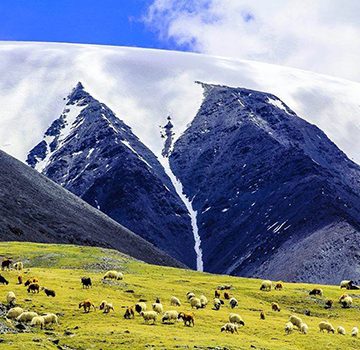General information about nature and environnement of Mongolia
Overall, the nature and environment of Mongolia are still in a good state of preservation;
primarily due to late urbanization, nomadic lifestyle traditionally sparing its resources to survive, and very respectful spirituality and harmony with the forces of Nature.
Biodiversity is significant, especially in the North and the West of the country. Air and water are remarkably pure outside the capital city.
Large geographical zones of the country are classified as natural reserves and protected areas. Some have had such status for centuries, so much Mongolians are concerned about their safeguarding.
Nevertheless, natural or human threats are real to these ecosystems, which remain fragile despite their magnitude. 200 vegetable species, 59 bird species and 28 mammal species are in danger or on the brink of extinction.
Frequent spring fires following dry winters as in 1996 had a devastating effect on significant surfaces. The very rigorous and snow abundant winters in 1999 and 2000 caused massive losses not only among domestic livestock but among wild species as well, especially gazelles and antelopes. The last two summer’s drought was alarming by its effect on the water level of rivers and wells. Desertification is taking place in the south of the country threatening to turn the steppes into deserts. The natural erosion of these windy grounds is accentuated by increased pressure on pastures after livestock privatization.
Combined with the high atmospheric pressures, Ulaanbaatar faces with significant air pollution, especially in the winter season, due to emissions of rapidly increasing automobile traffic, smoke from power stations and ger areas heated with fuel and coal.
Despite these threats to its virginity, Mongolia offers an example of inhabited natural environments, exploited but still little impacted by the presence of man, that have become rare elsewhere in the world.
Discover the Mongolia Fauna : Livestock and Wild Fauna
Livestock
It constitutes the most visible part of the abundant animal life and is composed of five species (Mongolians say “the five muzzles”) traditionally raised by the Mongols:
horses for riding and airag (or fermented mare’s milk),
sheeps and goats for meat, milk and wool (cashmere and felt cover for gers),
camels for hair and wool and for pulling the carts,
cows (or more frequently yaks in North) for milk, hair and leather.
Large reindeer herds are raised by Tsataans in the north.
Livestock herds graze freely and are brought back to ger settlements only in the evening. They enjoy semi-freedom and are partially watched over by herdsmen, mainly, to defend from wolves. Sheep and goats are usually packed at night near gers.
Livestock comprises almost 90% of the domestic agricultural industry and animal husbandry and is the principal occupation for the rural population. While the human population is about 2.6 million, there are 34.8 million cattle, sheep, goats, camels and horses in Mongolia.
Livestock equals capital for the rural population and meat is the staple diet. Besides the mining industry, the products of animal origin such as raw cashmer, horse hair, sheep wool, hides, meat and bonedust, and finished garments and products account for a substantial part of annual Mongolian exports.”
Wild Fauna
Apart from the domesticated animals, the most widespread mammal is unquestionably marmot, which perforates the steppes with millions of underground caves. Mongolians adore driving out into the steppes for amateur hunting to taste marmot cooking. Foxes, rabbits, squirrels, jerboas and other badgers also dig the ground or sand.
Wolves are present everywhere on the territory of Mongolia and represent a real threat to domestic livestock and, sometimes, lonely men in the steppes, especially in winter and at the beginning of spring. Their number is stable and is even increasing despite significant hunting by Mongolians and foreign hunters, followers of the great shiver. The possibility of seeing wolves in summer is rare like the chance to see other threatened species such as brown bear (much rarer Mazalai, Gobi’s brown bear), lynx, Saïga antelope, black tail gazelle, wild donkey and wild camel, moufflon and other Argali sheep of Gobi.
Nature and environment associations are successfully working towards nature conservation. Takhi or Przewalski horses, extinct for 40 years, were successfully reintroduced to Mongolia from European (and French) breeding.
Snow leopards are extremely rare. Its remaining population is estimated at few hundreds. Although strictly protected, they remain endangered due to poaching for its fur.
Mongolia is a paradise for bird lovers
Vultures, eagles, falcons, milans, magpies, cranes, corbels and larks are accompanied in summer by swans, geese, pelicans, herons and ducks. There are large colonies of gulls and other sea birds around certain lakes.
In summer, the steppe buzzes with myriad grasshoppers, which are made devour briskly by trouts, and others salmon species of good sizes, which populate the rivers and the lakes. Pike and pole are also abundant in the lakes. With the exception of brackish lakes and Tuul river heavily polluted around Ulaanbaatar, all water ways are very populated.
Fishing is rarely practiced in Mongolia. According to the traditional cosmology, the fish like the insects does not form part of the species that can be eaten by man. Nevertheless, traditions evolve and change and more Mongolians devote themselves to this sport and easily succeed even with rudimentary fishing gear.
Mongolia’s flora of Mongolia landscapes : Forest, Steppes, Meadows, Deserts …
Forests cover approximately 15% of the country’s territory. They consist primarily of pines and birches. They also shelter berry bushes and shrubs like the blueberry and blackcurrant trees and the potentille. Steppes and meadows cover 52% of the Mongolian grounds. In addition to the graminaceous omnipresent ones, the wild wormwood is widespread. Steppes blossom in spring and to a lesser extent in summer with myriad flowers such as edelweiss, gentians, geraniums, eyelets, delphiniums, peas, ancolies, rhododendrons, asters and others transforming Mongolia into an infinite garden.
Deserts (including the famous Gobi Desert) and semi-deserts occupy about 32% of the territory and are covered with sparse vegetation comprised mainly of saxauls and thorny bushes without leaves and with very deep roots.
Dinosaurs in Mongolia : Fossils of bones and eggs discovered in Mongolia
Since the first expeditions of Roy Chapman Andrews (the model of Indiana Jones!) in the early twenties, many rich layers of fossilized dinosaur bones and eggs have been discovered and studied Tyrannosaurus rex, protoceratops, tarbosaurus and others velociraptors haunted the steppes 700 million years ago.
The Natural History Museum of Ulaanbaatar exhibits two remarkable whole skeletons of tarsauborus and saurolophus as well as fossilized nests. Many discoveries found in Gobi are now scattered in museums and private collections around the world.






